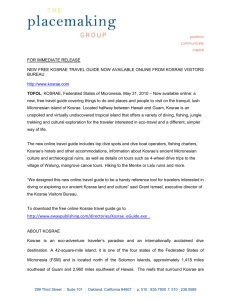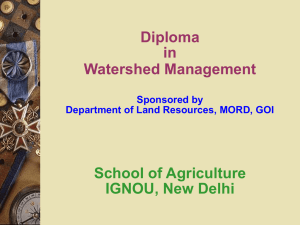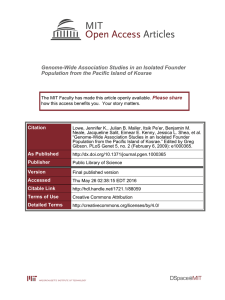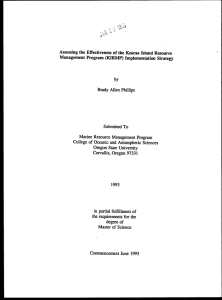EXECUTIVE SUMMARY
advertisement
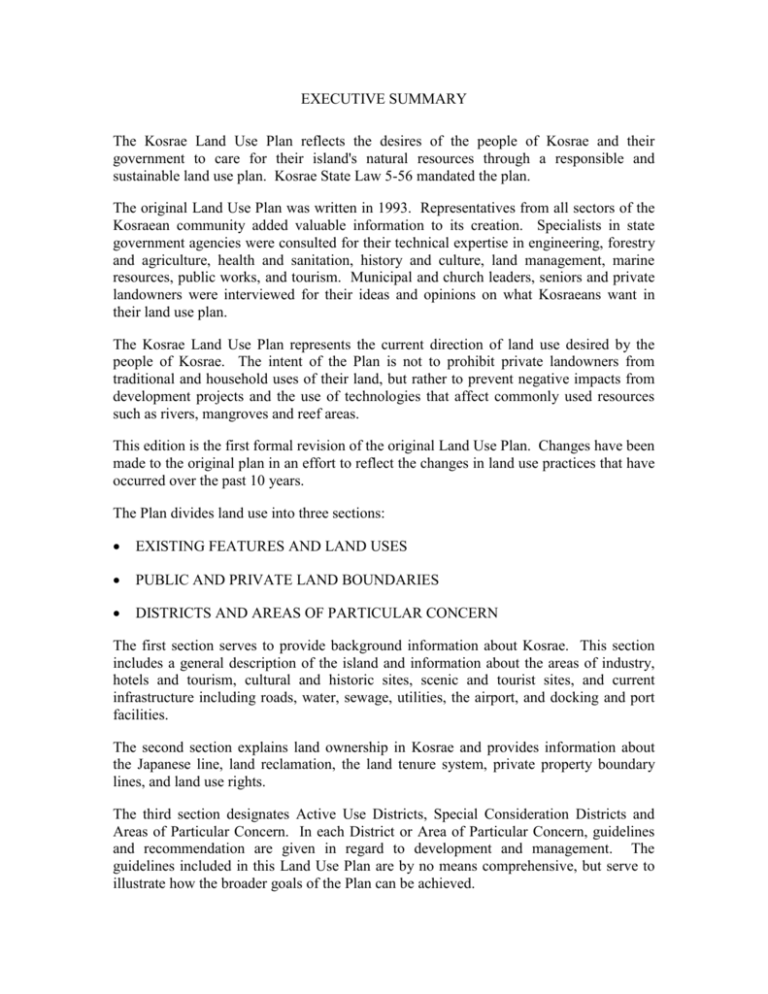
EXECUTIVE SUMMARY The Kosrae Land Use Plan reflects the desires of the people of Kosrae and their government to care for their island's natural resources through a responsible and sustainable land use plan. Kosrae State Law 5-56 mandated the plan. The original Land Use Plan was written in 1993. Representatives from all sectors of the Kosraean community added valuable information to its creation. Specialists in state government agencies were consulted for their technical expertise in engineering, forestry and agriculture, health and sanitation, history and culture, land management, marine resources, public works, and tourism. Municipal and church leaders, seniors and private landowners were interviewed for their ideas and opinions on what Kosraeans want in their land use plan. The Kosrae Land Use Plan represents the current direction of land use desired by the people of Kosrae. The intent of the Plan is not to prohibit private landowners from traditional and household uses of their land, but rather to prevent negative impacts from development projects and the use of technologies that affect commonly used resources such as rivers, mangroves and reef areas. This edition is the first formal revision of the original Land Use Plan. Changes have been made to the original plan in an effort to reflect the changes in land use practices that have occurred over the past 10 years. The Plan divides land use into three sections: EXISTING FEATURES AND LAND USES PUBLIC AND PRIVATE LAND BOUNDARIES DISTRICTS AND AREAS OF PARTICULAR CONCERN The first section serves to provide background information about Kosrae. This section includes a general description of the island and information about the areas of industry, hotels and tourism, cultural and historic sites, scenic and tourist sites, and current infrastructure including roads, water, sewage, utilities, the airport, and docking and port facilities. The second section explains land ownership in Kosrae and provides information about the Japanese line, land reclamation, the land tenure system, private property boundary lines, and land use rights. The third section designates Active Use Districts, Special Consideration Districts and Areas of Particular Concern. In each District or Area of Particular Concern, guidelines and recommendation are given in regard to development and management. The guidelines included in this Land Use Plan are by no means comprehensive, but serve to illustrate how the broader goals of the Plan can be achieved. In the original Land Use Plan, it was recommended that Specific Management Strategies and Components to the Strategies be created. The five Management Strategies were to cover Forests (Mangroves, Freshwater Wetlands, Upland, and Watershed Components), the Shoreline and Reef (Ocean Waters and Trochus Sanctuary Components), Waste Management, the Utwe-Walung Marine Park, and Cultural and Historic Site Preservation. Several of the Management Strategies have been written and are referenced throughout the Land Use Plan. Below are descriptions of the Districts and Areas of Particular Concern and the main guidelines and recommendations for each of them: ACTIVE USE DISTRICTS designate and recommend specific areas for Agriculture, the expansion of Residential areas, Industry, Waste Disposal and Treatment, Tourism, and Recreation/Marine Park. These Districts are recognized as the most appropriate areas for these particular types of development because of their location, accessibility and available infrastructure such as water and sewerage. The Agriculture District guidelines address the conversion of land to agricultural and agroforestry uses and the application and disposal of chemical fertilizers. Recommendations in this section requests that the relocation of the Japanese line be completed prior to the reclamation of land by citizens to allow for areas where acceptable agricultural and agroforestry practices could occur. In an effort to positively guide development and protect human and economic interests, a Residential District has been added to the plan where the construction of additional residences should be favored by government development of infrastructure and housing assistance programs whenever possible. Recommendations in this section are for the designation and development of lands within the Residential Active Use District. The Industrial District includes the Okat area south of Tafunsak village and the areas surrounding the Department of Public Works and the Kosrae Utilities Authority in Tofol. Examples of guidelines for this District include the preparation of a waste management plan and the use of vegetative buffers between industrial projects and residential areas. The section on Waste Disposal and Treatment was added to address the growing problems associated with current solid waste management practices. Recommendations for the development of Waste Disposal and Treatment Systems include finding a funding source to implement the 1997 Solid Waste Management Strategy, and addressing community awareness and educational outreach programs, dump site conditions, and current laws and regulations and their enforcement. The Tourist District has been identified as the area between Wiya in Tafunsak and Finpukal in Lelu. Guidelines for this District recommend landscaping plans and height limitations. The Marine Park District includes the area of Utwe Lagoon and the mangrove channel to Walung, and Western Utwema. Guidelines for this District address woodcutting limitations. A Marine Park Management Strategy is recommended for this District, as well as establishing boundaries using GPS technologies. SPECIAL CONSIDERATION DISTRICTS includes Mangroves, Freshwater Wetlands, Upland Forests, Ocean Waters from the reef crest to 12 miles out, the Shoreline and reef, and Highly Erodible Soils and Streambanks. These ecosystems are designated Special Consideration Districts because of their important ecological value to the sustained life of the island and because they require special review when being considered for development. Their overall land use goals are management and conservation. Guidelines for the Mangrove Special Consideration District cover wastewater and runoff, filling, clear-cutting, harvesting, and diversion and restriction of waterways. Additional technical guidelines can be found in the Mangrove Management Strategy. Guidelines for the Freshwater Wetlands Special Consideration District address filling, clear-cutting, harvesting, wastewater and runoff. Additional technical guidelines can be found in the Wetland Management Component. Guidelines in the Shoreline and Reef Special Consideration District address development proposals from 15 meters shoreward of the mean high water mark and seaward, the disruption and removal of inner portions of the reef flat, shoreline, coral boulders and live corals, the construction of coastal defenses, vegetative clearing and the mining of beach sand. Additional technical guidelines can be found in the Shoreline Management Plan. Guidelines for the Highly Erodible Soils and Streambanks Special Consideration District cover the suggested uses of highly erodible soils, and construction, roadbuilding and harvesting of trees on highly erodible soils and within streambanks. Additional technical guidelines can be found in the USDA Soil Conservation Service Soil Survey. Recommendations for the Upland Forest Special Consideration District include the pursuance of legal protection of the upland forest for watershed and biodiversity purposes, initiation of extension programs addressing soil erodibility, management of invasive plant species, and the preparation of the Upland Component of the Forest Management Strategy. Additional technical guidelines can be found in the Kosrae Watershed Assessment Recommendations in the Ocean Waters Special Consideration District include maintaining a current schedule of commercial shipping vessels’ presence, along with the disaster and emergency procedure plans. Guidelines can also be found under the PTI Agreement and NORMA. AREAS OF PARTICULAR CONCERN include Mangrove Reserves, Shoreline Erosion Hazard Areas, Rivers and Water Resources, Mouths of Rivers, the Trochus Sanctuary, the Green Snail Sanctuary, Cultural and Historic Sites, and areas identified by The Nature Conservancy as Areas of Biological Significance (ABS). These areas require the most comprehensive review in the development review process because of their sensitive ecological, cultural and social requirements. The Mangrove Management Component of the Forest Management Strategy identifies mangroves in the Okat-Yela area, from Infal Yela to Infal Okat, and the Utwe-Walung marine Park, from Molsron Tukunsru to Infal Yesron as the Mangrove Areas of Particular Concern. Recommendations for these areas include the drafting of specific rules and regulations governing human use of these areas. Shoreline Erosion Hazard Areas are designated in the Plan and guidelines include setbacks of 50 horizontal feet above the mean high water mark in which no development or sand-mining should occur. Additional guidelines can be found in the Shoreline Management Plan. The Rivers and Water Resources Areas of Particular Concern are divided into a Central Watershed Area and the eleven Primary Watershed areas that provide water to the villages in Kosrae. Pursuance of legal designation and boundaries for the Central Watershed Preserve is recommended as well as the development of a management plan for this area. Guidelines for all other watershed areas include establishing buffer zones along rivers in the watershed and requiring sedimentation control for development projects. The guidelines also address clearing and construction on slopes, the use of chemical fertilizers and pesticides, burning for clearing purposes and the maintenance of ground cover. It is recommended that inventories of water, soil, vegetation, and biodiversity be completed within the critical watersheds with subsequent monitoring of these areas. Additional guidelines can be found in the Watershed Management Plan. Guidelines for Mouths of Rivers include a buffer zone at the mouths of rivers, no changes in alignment of river channels, and special review of all manmade structures designed to control outflow along shorelines. Guidelines for the Trochus Sanctuary already exist in KSL 11.1101, but the Plan recommends expanding the Sanctuary to include other species of marine life and include the adjacent mangrove areas. No logging or development should occur in this area. Recommendations for the Green Snail Sanctuary include expanding the area to include the entire reef area, and prohibiting scuba diving, bottom fishing, spear fishing, hand-lining, gill netting and reef gleaning activities in this area. Guidelines for Cultural and Historic Sites prohibit the disruption of identified cultural and historic sites, and recommend the development of a Cultural and Historic Site Preservation Strategy. It is recommended that the Areas of Particular Concern identified by The Nature Conservancy as Areas of Biological Significance be addressed through implementation of the Kosrae State Biodiversity Strategy and Action Plan. Because the greatest potential for environmental damage comes from projects funded by large investors and governments, it is the intention of this plan that the guidelines and recommendations should be strictly enforced on development projects, government actions, and government funding assistance such as loans, equipment, extension programs, etc. Private land owners who wish to develop their own resources with traditional technologies should be given more flexibility. Ideally, public educational campaigns will lead to the voluntary compliance of these guidelines and recommendations by citizens and private landowners who wish to properly manage their own land. Areas of Particular Concern may require broader compliance from the government and citizens alike due to the fragile nature of these areas. The Plan uses eight overlay maps along with a High-Resolution IKONOS Satellite Image of the island to provide a visual picture of the sections described above. The maps provide decision makers with a tool to assess the potential impacts of a propose project based on its location. It is anticipated that the final version of the Plan will be incorporated into the proposed legislation the DRC is required to submit to the Legislature for the regulation of the use of land.
